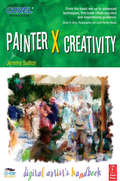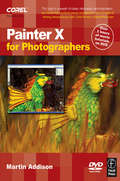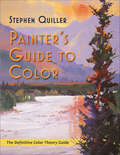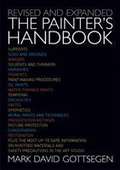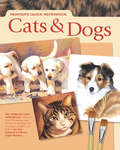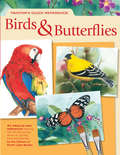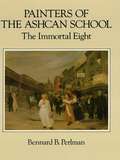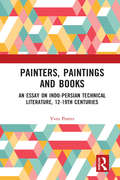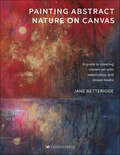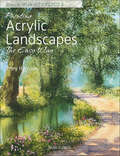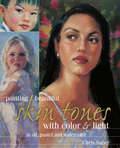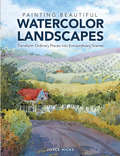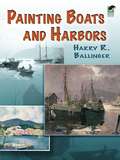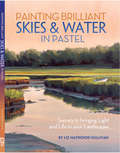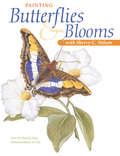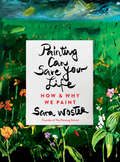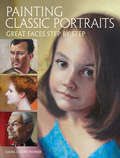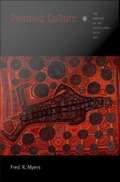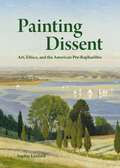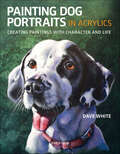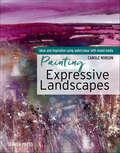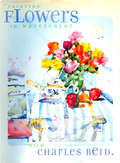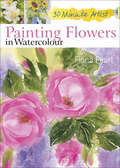- Table View
- List View
Painter X Creativity: Digital Artist's handbook
by Jeremy SuttonEmpower your artistry in the digital environmentThis unique Painter book addresses both creative and technical proficiency, helping you step ahead in today's world of photography, art, multimedia, and design. This lavishly illustrated guide speaks directly to all visual artists and shows you how to combine traditional and stateof-the-art media to capture the essence of your vision.Fully updated for Corel Painter X and the newest range of Wacom graphics tablets, progressive, well-structured tutorials from beginner to advanced level, case studies, and examples of art will inspire your imagination at every stage. Let world-renowned Painter master Jeremy Sutton guide you step-by-step in how to experiment with creative ideas and techniques that you can adapt to your own style.New time-saving tips, workflow strategies, and keyboard short cuts allow you to quickly transform your work with Corel Painter X's outstanding natural-media tools. From expressive paintings to evocative collage portraits, oil impressionism, live portrait paintings, and painterly effects for video, television, and the Web, you get the best techniques through...*Clear explanations with colorful screen grabs and inspiring artworks that lead youthrough the sophisticated and creative Painter tools*Practical, hands-on tutorials, and project illustrations that show you every step inimage development, including multimedia artist techniques*A CD-ROM packed with unique custom brushes, tutorial images, and additional artmaterials not supplied with Painter XIncluded on the resource CD:*48 extra brushes including many unique custom brushes not supplied with Painter *38 custom color sets*Jeremy's SupaDoopa custom palettes to help speed up your workflow*Collection of Jeremy's favorite Image Hose nozzles, paper textures, and patterns to greatly enhance the variety and richness of art materials available at your fingertips*Gain instant access to Jeremy's interface customization and optimize your creativity with unique custom workspaces, new to Painter X*4 QuickTime movies including a studio tour, artwork commentary, and details on Wacom tablets*Have fun practicing with 28 tutorial images!
Painter X for Photographers: Creating Painterly Images Step by Step
by Martin AddisonWhether you are just starting out with Painter, or are a seasoned pro who wants to take your photographs to the next level, you can't go wrong with this essential guide by your side! Covering Painter X, but also applicable to earlier versions and to both PC and Macintosh users, this reader friendly book and DVD package will show you how to get the most out of this powerful program. Uniquely written specifically for photographers, Martin Addison gives a complete overview of the program, showing how to master each exciting tool, including the brand-new RealBristle and Smart Stroke brush libraries. Two all-new portraiture chapters show you how to turn photographs of your family members or professional clients into works of art ideal for framing. You'll be able to give all of your precious photographs the painterly touch in no time! Be sure to visit the accompanying website www.painterforphotographers.co.uk to view even more images and information to get you started! Pictures by Martin and Doreen Addison can be seen on their website: www.martinanddoreen.co.uk.
Painter's Guide to Color: The Definitive Color Theory Guide
by Stephen QuillerThe Premier Guide for Painters to Understanding Color! Painter's Guide to Color was written foremost with the painter in mind. However, weavers, textile designers, interior decorators, and commercial artists have all benefited from award-winning artist Stephen Quiller's innovative and accessible color theory techniques. Painter's Guide to Color will help you to train your eye to see and use color in exciting ways.
Painter's Handbook
by Mark David GottsegenMuch more than just another guide to artists' materials, The Painter's Handbook is an amazingly useful resource, with information on everything from the canvas up: the canvas itself, plus paper, sizes and grounds, pigments and binders, solvents and thinners, varnishes and preservatives. Dozens of step-by-step recipes for make-it-yourself paints, pastels, varnishes, gessoes, sizes, supports, and equipment take this indispensable guide way beyond the competition. Authoritatively written by Mark David Gottsegen, chair of the federal government's ASTM committee on artist's materials, the revised Painter's Handbook considers the enormous changes in the art-materials world since the first edition was published in 1993. New materials, new health issues, new information on outmoded and even harmful supplies and practices mean that every painter needs a copy of The Painter's Handbook.
Painter's Life: Talks, Journals, Paintings
by Mari LyonsA Painter&’s Life is a rare glimpse into the mind of an uncompromising painter. Mari Lyons was a life-long &“every-day&” painter and from an early journal she kept for a short time she reveals the heartbreaks, the pain of rejection, the intense and abiding love of her work, and the quiet triumphs of a painter juggling the demanding life of a mother of four, a busy husband, constant financial pressure; she had a fierce desire to make ever-better work, and for her work to become more visible in the world. Later talks she gave at the Munson William Proctor Institute and Rider University frame the journal entries with the aesthetic concepts that animate her work. This look at her inner life is made more palpable by a selection of more than eighty-five representative paintings in color, along with sketches and photographs. Mari studied with Max Beckmann as a teenager, and later at Bard College, Yale-Norfolk, and with Stanley William Hayter. Her early work received high praise in college and from her first exhibition at the Polari Gallery in Woodstock when she was nineteen and still a student. She married at twenty-one, had three children in as many years, and then moved from the Midwest to New York City, where her fourth child was born.At first influenced by the Abstract Expressionists of the 1950s, she painted non-objectively but soon found the rich thingness of the world irresistible and her work developed into what she called &“painterly figuration.&” Her journals and notes reveal the intimate details of her long mediation between these two commitments. In time she exhibited regularly at the First Street Gallery in Chelsea and received praise in such places as The Wall Street Journal, The New Republic, The New York Times, The Sun, Forbes FYI, and elsewhere. Today her paintings are in The Museum of the City of New York, The New York State Museum, Bard College, The Montana Historical Society, Mills, Wellesley, and Russell Sage colleges, The Montana Museum of Art, and many other museums and private collections.
Painter's Quick Reference - Cats & Dogs: Cats And Dogs (Painter's Quick Reference)
by Editors of North Light BooksThe Perfect Reference for Painters!Paint your favorite furry companions! Inside you'll find more than 40 step-by-step demonstrations that clearly show how to accurately capture a variety of popular pet breeds, including tabby cats, terriers, bulldogs and many more.This detailed guide contains useful painting instruction and insights from 18 experienced artists working in acrylics, watercolor and oil. Whether you're painting a cat or dog portrait-style or playfully posed, this book will give you plenty of ideas and tips for nailing the unique details of the animal's face, body and individual personality.This invaluable combination of in-depth painting demonstrations and inspiring ideas is guaranteed to bring you success in all your work.
Painter's Quick Reference Birds & Butterflies: Birds And Butterflies
by Editors of North Light BooksThe perfect reference for painters! Brighten your paintings with colorful birds and butterflies. Inside you'll find more than 40 step-by-step demonstrations to help you accurately render beautiful butterflies and a wide variety of songbirds, water birds and exotic birds including goldfinches, hummingbirds, cardinals, mallards and peacocks. You'll also learn how to embellish your paintings with individual feathers, eggs and a nest. This special guide features painting instruction and advice from 11 professional artists working in acrylics, watercolors, oils and colored pencils. Each demonstration includes a detailed materials list to make it even easier for you follow along. This invaluable combination of in-depth painting demonstrations and inspiring ideas is guaranteed to bring you success in all your work.
Painters of the Ashcan School: The Immortal Eight
by Bennard B. PerlmanLively, scholarly, beautifully illustrated study of the 8 artists who brought a compelling new realism to American painting, 1870 to 1913. Henri, Glackens, Sloan, Luks, 4 more. 142 black-and-white illustrations. Bibliography. Introduction.
Painters, Paintings and Books: An Essay on Indo-Persian Technical Literature, 12-19th Centuries
by Yves PorterThe work aims at bringing the Persian texts into the study of the arts and technology of the Indo-lranian world – an approach much neglected so far. Drawing upon Persian sources (both from Iran and India), viz., technical treatises, historical chronicles and poetical texts, the work deals with painting and the art of book making during twelfth to nineteenth century.The introduction presents the geographical and chronological dimensions of the study. After a brief history of Persian painting before the twelfth century, the book discusses mural painting, manuscripts, origin of paper and its fabrication, the composition of the page, colours/pigments used in the paintings, painting subjects, bookbinding, etc. The painter, man and artist, his origin, his training, his status, aesthetics and taste, his workshop and its organisation and distribution of tasks therein, modular construction of the manuscripts, library, the caligraphy surrounding the painting, its illuminations and binding are all analysed. In fact the book reconstructs the entire process of making an illustrated manuscript from its ground work to its binding. Persian text and illustrations enhance the utility of the work.
Painters’ Playbooks in the Art Market of Early Modern Amsterdam (Studies in Early Modernity in The Netherlands)
by Weixuan W. LiThe art market in seventeenth-century Amsterdam is renowned as a competitive, multi-layered arena where diverse artists catered to a broad and varied clientele. How did this intricate market function? How did individual painters navigate this system, making business and artistic decisions that eventually gave shape to the so-called ‘Golden Age’ of Dutch art? Existing economic and art historical methodologies have fallen short of providing holistic explanations. Painters’ Playbooks introduces an innovative socio-spatial approach, using digital methods to examine the art market, shedding light on the artistic development in seventeenth-century Amsterdam. By synthesizing various historical sources digitally, this book delves into artists’ collective behaviours – or the ‘playbooks’ – discernible in their location choices, social relations, and use of house interiors. Analysing historical data through a socio-spatial lens, this book illustrates how the changes in artists’ playbooks not only shaped the multi-layered market structure but also influenced artistic innovation in seventeenth-century Amsterdam.
Painting Abstract Nature on Canvas: A Guide to Creating Vibrant Art with Watercolour and Mixed Media
by Jane BetteridgeThis exciting new title from best-selling author and artist Jane Betteridge explores how to create stunning abstract watercolour and mixed media art on canvas.The book contains short practical projects along with a comprehensive techniques section, three step-by-step projects, and is dotted throughout with Jane's sumptuous and inspirational finished artworks. The book encourages an experimental, semi-abstract approach to painting the natural landscape, and helps artists to loosen up.Activities that promote creativity, such as art, are seen as great ways to combat the stresses of modern life, and Jane's latest book will do just that. She provides expert guidance and exciting ideas that will allow anyone, whether beginner or experienced artist, to create amazing semi-abstract artwork.
Painting Acrylic Landscapes the Easy Way: Brush with acrylics 2
by Terry Harrison1) Terry Harrison takes the mystery out of acrylic painting in this clear guide to achieving impressive effects with just a few strokes of the brush. 2) Six beautiful step by step demonstrations and plenty of tips and techniques make acrylic landscape painting achievable. 3) This book will give confidence to the beginner and will also inspire more experienced artists.
Painting Beautiful Skin Tones with Color & Light: Oil, Pastel and Watercolor
by Chris SaperYou can paint realistic skin tones that glow with life!Learning how to capture such quality has never been easier. Inside you'll find guidelines for rendering accurate skin tones in a variety of media, including watercolor, oil and pastel.You'll begin with a review of the five essential painting elements (drawing, value, color, composition and edges), then learn how light and color influence the appearance of skin tones. Artist Chris Saper provides the advice and examples that make every lesson and technique easy to understand--immediately improving the quality of your work. You'll discover how to:Paint the four major skin color groups (Caucasian, African American, Asian and Hispanic)Refine these colors into dozens of possible variations within each groupSelect your palette and mix hues for clean, beautiful colorsDetermine the color and temperature of light that falls on your subjectPaint direct and indirect sunlight, artificial light and highlights of lightMaster the four elements that determine color in shadowUse photographic references when you can't paint directly from lifeYou'll also find seven step-by-step demonstrations and an appendix of sample color charts for each major skin type under a range of lighting variations. It's all you need to bring your portraits to life!
Painting Beautiful Watercolor Landscapes: Transform Ordinary Places into Extraordinary Scenes
by Joyce HicksTransform Ordinary Places into Extraordinary Scenes
Painting Boats and Harbors
by Harry R. BallingerArtists who love the sea and dream of capturing every aspect of its beauty will treasure this lavishly illustrated guide to painting boats, skies, and picturesque harbors. Written by an award-winning artist and teacher with decades of experience in the genre, this step-by-step guide covers every topic from art materials and equipment through composition and painting techniques.Seasoned artists and novices alike will appreciate the author's simple, yet authoritative style. In clear, nontechnical language, he discusses the structure of boats, offers advice on choosing a subject to paint, and shows how to avoid the pitfalls that can await painters of the sea. On its own, or as a companion volume to Ballinger's Painting Surf and Sea, this volume will inspire any artist with the desire to produce beautiful seascapes. Includes eighty-five black-and-white illustrations and an eight-page insert with nine color illustrations.
Painting Brilliant Skies & Water in Pastel: Secrets to Bringing Light and Life to Your Landscapes
by Liz Haywood-SullivanFrom skies above to water below, discover the secrets to glorious landscapes! No two elements of the landscape bring the artist greater inspiration--or greater challenge--than sky and water. Get them right and you have magic. Get them wrong and your whole painting is off. In this book, popular pastel artist and teacher Liz Haywood-Sullivan shares her secrets for getting them both right, every time. With her practiced and proven approach, you can experience the joy of painting glowing skies and sparkling water. Inside you'll find: 24 step-by-step demonstrations showing the creation of breathtaking skies and water in pastel. Techniques for painting skies, including the various types of clouds and how light changes depending on the season and time of day. How to depict water in all its forms, from calm, reflective ponds and meandering rivers to whitewater cascades and ocean waves. A clear and simple approach to the puzzling concepts of aerial perspective and the nature of reflections. A primer on materials to help novice artists and newcomers get started in pastel. Beautifully illustrated with stunning landscapes, Painting Brilliant Skies and Water in Pastel is a must for artists who have not found the targeted help they seek in other landscape painting books. Use it to make the most of natures' inspiration and pour mood, movement, and poetry into your paintings.
Painting Butterflies & Blooms with Sherry C. Nelson
by Sherry C. NelsonPaint a World of Beautiful Butterflies Delicate, majestic and diverse, the butterfly is an eternal source of inspiration and wonder. Now you can learn to capture the radiant beauty and delicate details of the world's most spectacular butterfly species in glowing oil paintings. Renowned artist and teacher Sherry C. Nelson takes you on a global expedition featuring more than 50 captivating butterflies and blooms for you to paint, study and admire–all in an easy-to-use reference-book format. You can do it! Sherry makes painting butterflies achievable with simple steps, visual examples, and clear instructions. Starting with the basics, you'll learn how to transfer designs, select and mix colors, and create a range of harmonious backgrounds. Next, Sherry guides you from start to finish through 54 step-by-step demonstrations for painting butterflies, moths and flowers of all sizes, shapes and colors. Each butterfly is painted in a vignette featuring flowers and foliage that are part of its native habitat or food source. Sherry also includes crisp reference photos and traceable line drawings that allow you to paint the demos exactly as they are, or you can incorporate them into your own paintings of the natural world. The creative possibilities are up to you. With this guide, you can capture your most beloved butterflies with skill and satisfaction. No net required!
Painting Can Save Your Life: How and Why We Paint
by Sara WosterArtist and founder of The Painting School Sara Woster invites readers into the vibrant world of painting as a creative practice powerful enough to transform our lives.Sara Woster is a painter, teacher, and art evangelist. She believes in art as a form of mindfulness, a ritual for healing, and an outlet for self-expression. In Painting Can Save Your Life, Woster welcomes readers into this transformative art form, inviting them to pick up a brush and discover how painting can help you see the world in a whole new way. Weaving soup-to-nuts instruction on how to paint—from choosing the right materials to painting the human body—with her own story of discovering a passion for painting, this book includes: simple and easy techniques for painters of all skill levelsplayful and challenging painting exercisestips on how to build a creative community using artinsights on how to use painting to cultivate a sense of calm in a stressful world Part how-to-paint, part sheer inspiration, Painting Can Save Your Life is a wise and inspiring guide to the power of painting.
Painting Classic Portraits: Great Faces Step by Step
by Luana Luconi WinnerEasy techniques for true-to-life portraits! If you think all portrait-painting books are the same, think again. This book will inspire you to approach your canvas with renewed (or newly discovered) enthusiasm and confidence. Using modern-day techniques, Luana Luconi Winner shows you how to capture not only a physical likeness, but also the personality and unique, natural expression of your subject. Her direct, relaxed teaching style takes the intimidation out of painting portraits, empowering artists of any skill level and medium to turn ordinary people into exceptional works of art. Time-tested, easy-to-follow techniques for achieving accurate facial shapes and proportions. 10 quick-reference color charts make it easy to mix skin tones and hair colors for a full range of complexions and ethnicities. Mini-demonstrations show how to use a variety of mediums--graphite, charcoal, pastels, watercolor and oils--to create sketches and preliminary studies. Tips on using a digital camera to generate reference material and troubleshoot your compositions. Three start-to-finish painting demonstrations in oils and pastels illustrate the particulars of painting males and females, adults and children. Destined to become a classic in its own right, Painting Classic Portraits covers every step in the process--from selecting clothes, backgrounds and props that tell a story, to using design elements to stir emotion in your viewers. It's everything you need to know to create timeless portraits and great paintings.
Painting Culture: The Making of an Aboriginal High Art
by Fred R. MyersPainting Culture tells the complex story of how, over the past three decades, the acrylic "dot" paintings of central Australia were transformed into objects of international high art, eagerly sought by upscale galleries and collectors. Since the early 1970s, Fred R. Myers has studied--often as a participant-observer--the Pintupi, one of several Aboriginal groups who paint the famous acrylic works. Describing their paintings and the complicated cultural issues they raise, Myers looks at how the paintings represent Aboriginal people and their culture and how their heritage is translated into exchangeable values. He tracks the way these paintings become high art as they move outward from indigenous communities through and among other social institutions--the world of dealers, museums, and critics. At the same time, he shows how this change in the status of the acrylic paintings is directly related to the initiative of the painters themselves and their hopes for greater levels of recognition. Painting Culture describes in detail the actual practice of painting, insisting that such a focus is necessary to engage directly with the role of the art in the lives of contemporary Aboriginals. The book includes a unique local art history, a study of the complete corpus of two painters over a two-year period. It also explores the awkward local issues around the valuation and sale of the acrylic paintings, traces the shifting approaches of the Australian government and key organizations such as the Aboriginal Arts Board to the promotion of the work, and describes the early and subsequent phases of the works' inclusion in major Australian and international exhibitions. Myers provides an account of some of the events related to these exhibits, most notably the Asia Society's 1988 "Dreamings" show in New York, which was so pivotal in bringing the work to North American notice. He also traces the approaches and concerns of dealers, ranging from semi-tourist outlets in Alice Springs to more prestigious venues in Sydney and Melbourne. With its innovative approach to the transnational circulation of culture, this book will appeal to art historians, as well as those in cultural anthropology, cultural studies, museum studies, and performance studies.
Painting Dissent: Art, Ethics, and the American Pre-Raphaelites
by Sophie LynfordA revelatory history of the first artist collective in the United States and its effort to reshape nineteenth-century art, culture, and politicsThe American Pre-Raphaelites founded a uniquely interdisciplinary movement composed of politically radical abolitionist artists and like-minded architects, critics, and scientists. Active during the Civil War, this dynamic collective united in a spirit of protest, seeking sweeping reforms of national art and culture. Painting Dissent recovers the American Pre-Raphaelites from the margins of history and situates them at the center of transatlantic debates about art, slavery, education, and politics.Artists such as Thomas Charles Farrer and John Henry Hill championed a new style of landscape painting characterized by vibrant palettes, antipicturesque compositions, and meticulous brushwork. Their radicalism, however, was not solely one of style. Sophie Lynford traces how the American Pre-Raphaelites proclaimed themselves catalysts of a wide-ranging reform movement that staged politically motivated interventions in multiple cultural arenas, from architecture and criticism to collecting, exhibition design, and higher education. She examines how they publicly rejected their prominent contemporaries, the artists known as the Hudson River School, and how they offered incisive critiques of antebellum society by importing British models of landscape theory and practice.Beautifully illustrated and drawing on a wealth of archival material, Painting Dissent transforms our understanding of how American artists depicted the nation during the most turbulent decades of the nineteenth century.
Painting Dog Portraits in Acrylics: Creating Paintings with Character and Life
by Dave White'This is a thorough and thoughtful guide that delivers on every count.' Artbookreview.netWith a passion for animals that is evident throughout, animal portrait artist Dave White, also offers basic advice for beginners along with more advanced techniques suitable for experienced artists who wish to capture the spirit and character of dogs in their portraits. Beginning with detailed guidance on composition, colour and choosing your reference material, Dave White teaches you the essential painting techniques you'll need to start creating your own artworks – from producing an outline and underpainting to capturing the three-dimensional qualities of your pet that will make your paintings truly stand out, such as realistic hair and whiskers, getting the shine on a nose and a glint in an eye, and whether to show ears up or down or the tongues in or out. To follow, the author then offers three step-by-step projects of varying subjects – including a short-haired dog, a long-haired dog and a group portrait – which have been specially designed to encourage you to tackle the essential poses you'll need to start painting your own pooches. The book ends with a short section providing practical advice on setting up and running your own pet portrait business.
Painting Expressive Landscapes: Ideas and Inspiration Using Watercolour With Mixed Media
by Carole Robson'This is busy, colourful, packed with information and thoroughly inspiring and I love it...buy this book.' Artbookreview.netStrongly influenced by the changing landscape, Carole Robson’s artwork is packed with colour, atmosphere, texture and light. An experienced teacher and artist, Carole explores how to build from basic techniques to producing wonderful expressive and semi-abstract landscapes. Combining watercolour with other watersoluble media and collage material, the three detailed step-by-step projects demonstrate perfectly Carole’s expertise and innovative methods. They take you from materials and tools needed through to using masking fluid, salt, spattering techniques, modelling paste, cellophane and much more.A stimulating mix of colour and watercolour techniques for all skill levels, this guide helps the artist develop a free and flowing style to their art.
Painting Flowers in Watercolor with Charles Reid
by Charles ReidCharles Reid is one of watercolor's best-loved teachers, a master painter whose signature style captures bright floral still-lifes with a loose spontaneity that adds immeasurably to the whole composition.Portraying the glory of nature in a highly individual way is the ultimate challenge for all painters, and with this book, Charles Reid shares with you the instruction and advice you need to paint fruits, vegetables and flowers that glow.Special "assignments" and step-by-step demonstrations help you master techniques for superior brushwork, edge control, and composition. You'll learn to paint wild daffodils, roses, mums, sunflowers, lilacs, tomatoes, avocados, oranges, strawberries, jars, coffeepots, wine bottles and more.Reid also shows you how to paint flowers in any environment, from the tranquility of a warm kitchen to a windswept beach in Bermuda. You'll create a garden of floral glories--compositions that burst with light, color and realism.Best of all, as your proficiency for capturing the essence of flowers builds, so too will your personal style. Soon your paintings will depict the beauty of nature in your own individual fashion.Let Charles Reid show you how to create beautiful watercolor florals from start to finish!
Painting Flowers in Watercolour (30 Minute Artist)
by Fiona PeartGot a half hour? Use it to paint something beautiful with these ten quick projects.The 30 Minute Artist series is for beginners and busy artists who want to achieve great paintings in just half an hour. Here, expert artist and teacher Fiona Peart helps you build skills and confidence, and loosen up your style, by producing spontaneous, lively flower paintings in thirty minutes flat. Discover quick exercises to get you started—and then try the ten fantastic step-by-step projects, from a jug of daffodils to sunflowers to spring violas—for a delightful creative break in your day.
